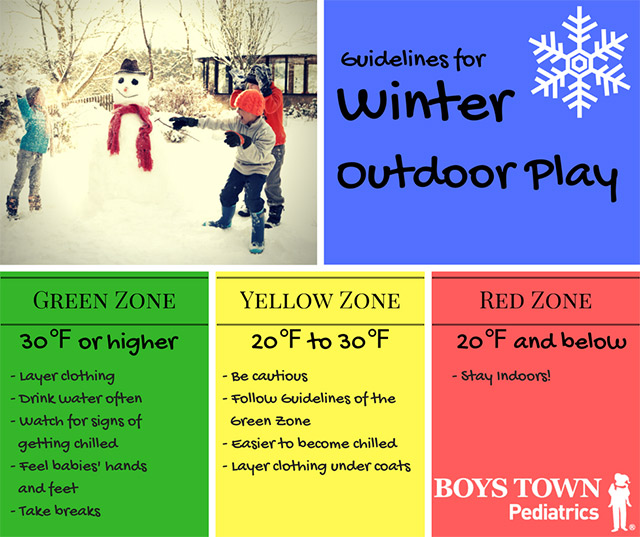Hypothermia in Children
When playing outside in the cold and snow, a child’s body can lose heat quickly. A child’s normal core temperature ranges from 98-99 degrees; hypothermia occurs when it drops below 95 degrees.
Hypothermia Signs
Hypothermia warning signs include:
- Body shivers
- Fingers and toes feel numb
- Exposed skin may look puffy and blue
- Lack of coordination
- Muscle aches
- Difficulty walking
- Mental confusion
- Slower breathing and heart rate
- Irregular or erratic heart beat
Treating Hypothermia
Because severe hypothermia can be a life-threatening condition, a child with any level of hypothermia needs prompt attention. Below are quick steps for treating hypothermia:
- Remove the person from the cold and remove any wet clothing
- Warm the person with warm blankets around the body, especially the neck and chest.
- Offer a warm beverage if the person is able to drink.
- Share body heat by using skin-to-skin contact by lying next to the child.
- Cover yourself and the child with a warm blanket.
- If your child begins shaking violently or becomes confused, call 9-1-1.
- If breathing becomes very shallow or non-existent, begin CPR.
Winter Play Safety Tips
Boys Town Pediatrics encourages monitored outdoor play during the winter months. Making snow angels, snowmen and sledding are fun family activities. The best way to protect your child from hypothermia and other cold injuries is to prevent them from ever happening. Just remember to keep it safe by following these winter safety tips from Boys Town Pediatrics:
-
Stay covered by wearing a hat.
-
Keep dry by wearing waterproof gloves and boots.
-
Play smart and come inside every 30-60 minutes to warm up.
-
Wear layers to help stay comfortable during play.
If your child begins to complain of being cold or wet, make sure to take a break from play - go inside and grab a warm drink. Stay warm, have fun and enjoy this winter season!
Temperature Guide
When is it too cold for your child to go outside and play? Follow the colored safety zone guide.
-
Green zone. The safest temperature to go outside to play is 30 degrees or higher.
-
Yellow zone. Playing in temperatures between 20 to 30 degrees should be carefully watched by parents as the weather will affect body temperatures to cool quickly.
-
Red zone. Your child should not play outside in temperatures less than 20 degrees. Keep in mind the wind chill factor can cause the actual temperature outside to be much colder, especially if skin is not properly covered.

Outdoors;Health and Safety
